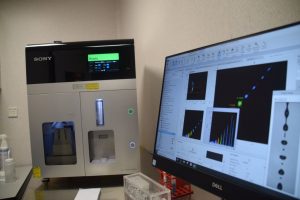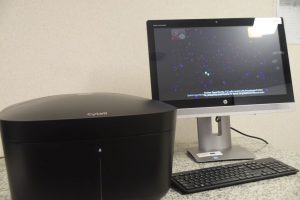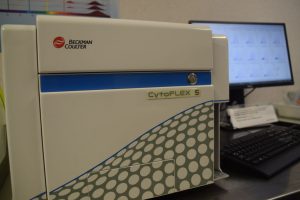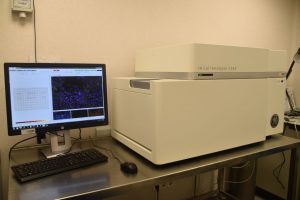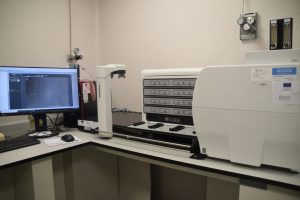
Flow Cytometry and Cytomics
The CIPF Cytomics Core Facility includes advanced technology and equipment for polychromatic flow cytometry analysis, fluorescence-activated cell sorting (FACS), and high-content screening (HCS) assays. The core was created in 1983 by Dr. José Enrique O’Connor, a Senior Professor at the University of Valencia and the original founder of flow cytometry in Spain. It is now run by Dr. Alicia Martínez-Romero and Domingo Gil Casanova.
The role of the Cytomics Facility is to support the use of its equipment by the research labs at the CIPF and by external researchers. Flow cytometry and image analysis are useful techniques in basic and translational biomedical research, as well as in other disciplines such as toxicology, cellular biology, biotechnology, environmental sciences, and microbiology.
The staff in the Cytomics Facility perform the maintenance and quality control of all the instruments to ensure their accuracy. In addition, they also offer technical support to help researchers use the equipment, as well as scientific support to help adapt and apply these technologies to different applications proposed by investigators. Therefore, the facility has prepared several protocols for pre-defined applications, and in addition, the staff can also help researchers to develop customized protocols to suit the specific requirements of their experiments.
Finally, the Cytomics Facility staff are involved in a wide variety of training tasks, including organizing and hosting an annual basic flow cytometry course accredited by the Comisión de Formación Continuada de las Profesiones Sanitarias (Commission for the Continuing Education of Health Professions) at the CIPF. In addition, they also participate in the International Cytometry Summer School, organized by the European Society for Clinical Cell Analysis (ESCCA).
- Equipment and Resources
- Services
- Protocols
- A Cytomics FC500 MCL (Beckman-Coulter, CA, USA) flow cytometer equipped with one laser (488 nm) and 5 fluorescence detectors.
- A CytoFLEX S (Beckman-Coulter, CA, USA) flow cytometer equipped with 4 lasers (405 nm, 488 nm, 561 nm, and 635 nm) and 13 fluorescence detectors.
- A High-Speed Cell Sorter MoFlo XDP (Beckman-Coulter, CA, USA) equipped with three lasers (351 nm, 488 nm, and 635 nm) and 8 fluorescence detectors which can simultaneously separate four different cell populations.
- A HCS system IN Cell Analyzer 2200 (Cytiva, UK), which can quickly acquire and analyze fluorescence images. This equipment has temperature and CO2 controls and works with several different format cell culture flasks, multi-well plates, and slides. Therefore, it can be used in experiments to work with live cells over long time periods. This instrument also has an objective that can reach up to 40× and can simultaneously acquire 4 fluorescent channels, and brightfield and phase-contrast images.
- A Cytell image system (Cytiva, UK)—a self-service bench-top instrument that is fast and easy to use. It has an objective that can reach up to 10× and can acquire 4 fluorescent channels and 1 brightfield image. This system works with several cell culture flask, multi-well plate, and slide formats.
- A Cyation 5 cell imaging system (BioTek, USA) equipped with its own cell BioSpa 8 incubator (BioTek, USA). The combination of both these systems allows simultaneous imaging experiments to be performed over long time periods, in up to 8 plates, combining different reading protocols in the same imaging system. Therefore, this system allows experiments lasting 3 weeks or more to be carried out while maintaining continuous, stable cell culture conditions.
The Cytomics Core Facility offers different levels of services according to the user’s preferences:
- Sample processing. The facility can handle cell samples of different origins including immortalized cell lines, primary cultures, and cell samples and biological fluids from tissues, bacteria, or algae. The expert staff has specialized knowledge of the optimal protocol for use according to each experimental design.
- Sample acquisition in the different Core Facility instruments. This includes flow cytometry setup and acquisition, end-point image analysis, and time-lapse experiments, all while maintaining the samples in stable cell culture conditions.
- Cell sorting to obtain purified cell populations based on the immunophenotype and/or functional features, including:
- Purification of rare cells from a heterogeneous sample
- Sorting eukaryotic and procaryotic cells.
- Simultaneously sorting up to 4 cell populations.
- High-purity cell sorting.
- Optimized recovery of intact/viable cells for further analyzes such as PCR, DNA sequencing, cell culture, use in animal models, etc.
- Results analysis and interpretation. The Cytomics Facility staff can analyze the flow cytometry and HCS results using specific software.
- Consultation regarding experimental design.
- Design and implementation of comprehensive studies based on the analysis of cytometric results.
Flow cytometry protocols
- Immunophenotyping of samples by flow cytometry to detect the expression of surface and intracellular/intranuclear antigens. The design of multicolor experiments using up to 13 different fluorescent markers, with automated compensation using calibration beads.
- Cell-cycle analysis. Several DNA probes with different fluorescence spectra are available for use in live or fixed cells. These can also be combined with other markers to simultaneously quantify the DNA content alongside other cell structures/functions.
- Cytotoxicity assays used to assess cell death and investigate specific apoptosis pathways including annexin V/propidium iodide, active caspase detection, or cytochrome C detection.
- Characterization of internalization and endocytic processes for nanoparticles or microvesicles, among other uses.
- The characterization of intracellular signaling pathways.
- Functional tests in established cell lines, primary cultures, and ex vivo samples such as oxidative stress assays, experiments to measure mitochondrial membrane potential, and detection and determination of intracellular pH, calcium, or other ions.
- Microorganism cell characterization for applications in biotechnology and environmental sciences.
- The functional and immunophenotypic characterization of stem cells.
- Real-time analysis of kinetic parameters (analysis In Fluxo).
- Detection and analysis of microvesicles/microparticles. Fluorescent particles as small as 100 nm can be detected. Microvesicles derived from in vitro cell cultures and from ex vivo samples can be analyzed using the CytoFLEX S high sensitivity flow cytometer.
Image analysis protocols
High-content studies (HCS) using image analysis techniques for cell cultures and tissue sections. This allows the detection and quantification of different cell parameters (which is especially useful in toxicology and drug discovery fields) with temperature and CO2 control so that long-term experiments with live cells can be carried out.
- Acquisition and analysis of cell substructures, whole cells, tissues, and spheroids.
- Protein localization and trafficking and cytoplasm–nuclear translocation studies.
- Co-localization experiments.
- Functional studies in live cells: mitochondrial activity, ion movements, and pH changes.
- Neurite outgrowth and neuronal function.
- Cell phenotype profiling.
- Nuclear substructure analysis.
- Organelle morphology studies.
- Microtubule analysis.
- Mitotic structure analysis and cell cycle studies.
- Cell adhesion and migration assays.
- Time-course analyses.
- Stem cell analyses.
- Experiments with multi-cellular structures: e.g., stem cell colonies or spheroids for drug discovery in cancer research.
CYTATION 5
IN CELL ANALYZER
CYTOFLEX
CYTELL
CELL SORTER
Contact the Cytomics Core Facility for more information:
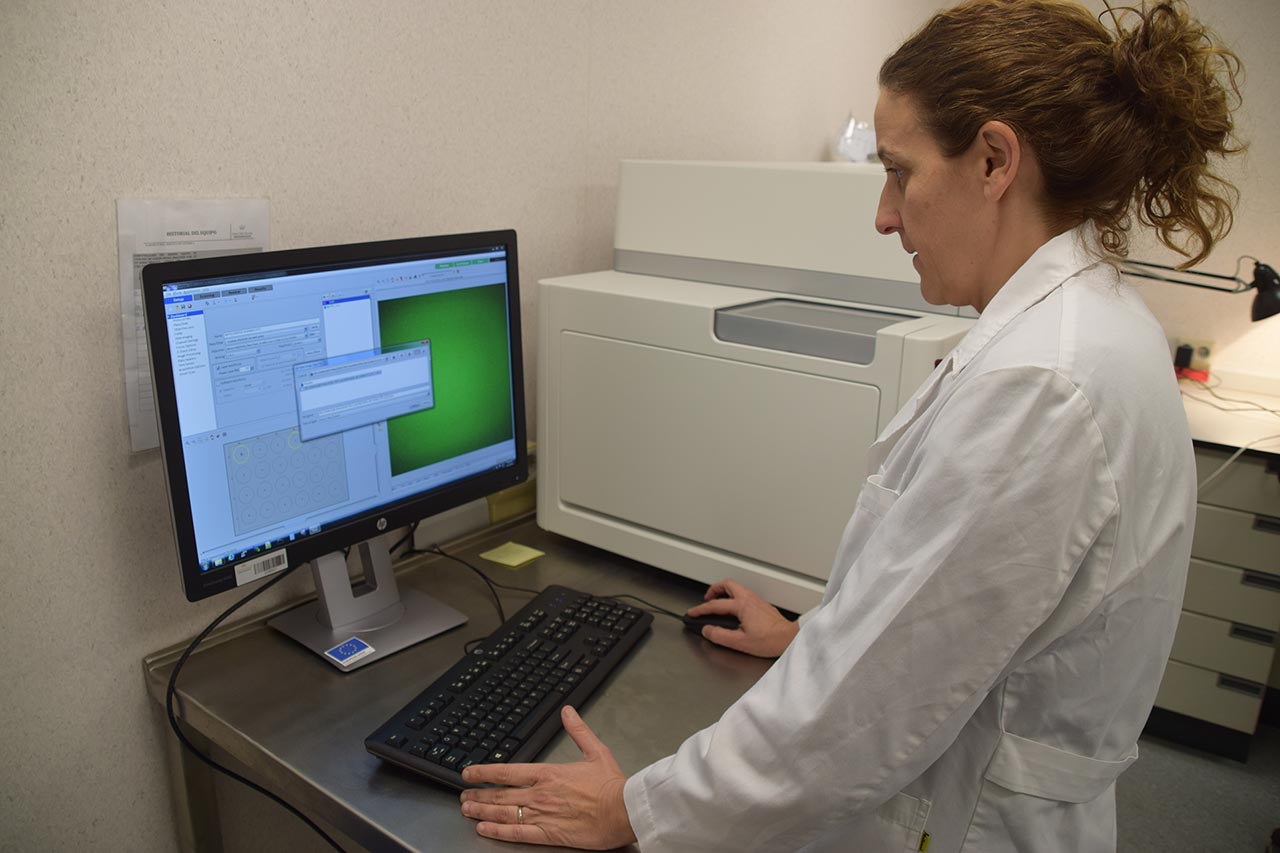
Alicia Martinez / Domingo Gil
citomica@cipf.es
963289681 ext. 3112 / 3111

